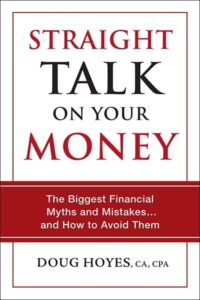 Should you cash in your RRSP to pay off debt? While some prospective retirees may be tempted to do so, this is one of a score of damaging financial myths, according to insolvency trustee and author Doug Hoyes.
Should you cash in your RRSP to pay off debt? While some prospective retirees may be tempted to do so, this is one of a score of damaging financial myths, according to insolvency trustee and author Doug Hoyes.
I mention this in my latest MoneySense Retired Money column, which has just been published. You can retrieve it by clicking on the highlighted headline here: The wrong way to pay off Debt.
As I say in the article, Cashing in your RRSP to pay off debt is Myth #9 of 22 common financial misconceptions outlined in Hoyes’ new book, Straight Talk on Your Money (cover shown adjacent: we share a common publisher.)
Hoyes is particularly concerned about senior debt in Canada and how these myths can affect their retirement. Myth #10 often afflicts retired seniors: that Payday Loans are a Short-term Fix for a Temporary Problem.
Seniors racking up debt faster than other age groups
Earlier this week in the Financial Post, columnist Garry Marr reported that Seniors in Canada are racking up debt faster than the rest of the population. Over the past year, senior debt grew by 4.3%, according to a survey published Tuesday by Atlanta-based Equifax Inc.
Personally, I believe that those still in debt shouldn’t even be considering retirement. And if retirement is an important future goal, it doesn’t make a lot of sense to plunder what retirement savings you have managed to accumulate just to get your debt lower at today’s still-low interest rates. For one, there are tax consequences to withdrawing funds from an RRSP or a Locked-in Retirement Account (LIRA). If the withdrawal moves you into a higher tax bracket, “it’s possible you could lose half your funds to the tax man,” Hoyes says.

If you’re so in debt that you are considering bankruptcy or a consumer proposal, “It often makes no sense to cash in your retirement accounts,” Hoyes says. Besides, while RRSPs have fewer strings attached to them, “cashing out” of a LIRA is more problematic since, as the term suggests, the money is “locked in” for its true purpose: your eventual retirement.
A better source of funds, if you have them, are non-registered investment accounts. This also may have tax consequences (primarily capital gains) but they are likely to be less severe than plundering your RRSP.
One reason Hoyes prefers this route is that in a bankruptcy, unregistered assets are seizable by creditors. By contrast, it’s unlikely that you will lose your RRSP or LIRA in a bankruptcy. In a bankruptcy “you will lose the investments anyway, so it makes sense to cash them in, pay your debts, and avoid bankruptcy,” Hoyes writes in the book.
Interest-rate spread between debt and deposits could alter decision
As you can see from one of the three related links below, all written by him, Hoyes and the Hub have tackled this topic before. See for example Hoyes’ 2015 Hub post titled Should you cash in your RRSP to pay off debt?
The answer then as now continues to be “No” although the gambit might make sense if you’re paying a very high rate of interest on credit cards and are receiving very low returns on fixed-income investments in your RRSP. To borrow from Hoyes’ blog, “if you owe $10,000 on credit cards with a 20% interest rate, and you are earning 1% in a GIC in your RRSP, cashing in your RRSP to pay off the debt, and saving 20% interest, may make sense.”
But note the alternatives, which may include a consumer proposal or even bankruptcy. And that’s coming from a licensed insolvency trustee and now author.

